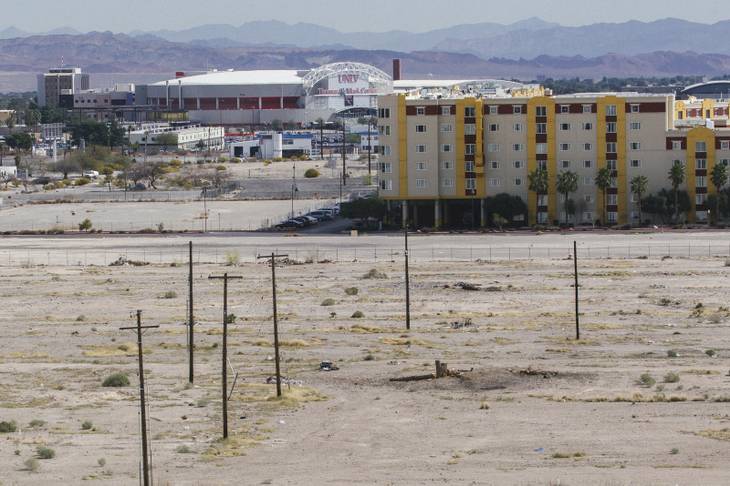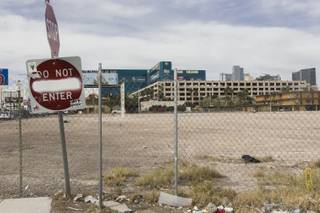Where would Beyonce perform if she came to Las Vegas for a one-night concert soon?
The music superstar’s world tour this year includes stops at massive venues across the United States: AT&T Stadium near Dallas, the Rose Bowl near Los Angeles, Levi’s Stadium near San Jose and CenturyLink Field in Seattle, to name a few.
Each stadium is larger than anything Las Vegas has to offer. The Rose Bowl seats about 95,000, for example, and Levi’s — where the Super Bowl was just held — seats about 68,500. The most comparable space in Las Vegas, Sam Boyd Stadium, seats about 40,000, and the T-Mobile Arena that opens on the Strip in April will seat half that.
So even if Beyonce’s tour wanted to stop in Las Vegas, the self-proclaimed entertainment capital of the world just doesn’t have a venue that can accommodate such a large event.
That could change for future acts, however, if a plan supported by Las Vegas Sands Corp. and Majestic Realty Co. moves forward this year. The companies want to build a stadium on land owned by UNLV that would likely be domed, seat about 65,000 people, cost at least $1 billion and rely to some extent on tourism-based taxes.
Supporters of the stadium say it would be a major driver of tourism to Las Vegas partly because it could host a range of events — such as a big stadium concert — that can’t fit in any of the area’s current venues. Yet some experts, and even the head of MGM Resorts International, have raised questions about the project’s impact and possible sources of funding.
Related Content
- If we build a football stadium, we can also rebuild UNLV
- Raiders owner Mark Davis intrigued by Las Vegas as NFL city
- Goodell: If owners approve it, Raiders can move to Las Vegas
- Having NFL, Raiders in Las Vegas seems right, just unlikely
- UNLV likes Sands-backed stadium for NFL team but isn’t married to it yet
The most significant potential use of the stadium would be to host an NFL franchise. Mark Davis, owner of the Oakland Raiders, met with Las Vegas Sands CEO Sheldon Adelson in January as the team explored relocating to Southern Nevada.
But an NFL team isn’t necessary to make the stadium happen, supporters say. The venue is also envisioned as home of the UNLV football team, and could also host other athletic and entertainment events each year.
A previous analysis of the potential for a large stadium in Las Vegas — which predates the most recent proposal — said a venue like that could bring at least 15 new large events to town. Those include, potentially, an extra college bowl game, neutral site college football games, soccer matches, huge concerts and more.
The idea is those events will help draw even more tourists to Las Vegas, including many who would otherwise never make the trip.
“Some folks have called (a stadium) sort of the missing link, if you will, of the tourism offerings of this town,” said Ron Reese, a Las Vegas Sands spokesman. “Unquestionably, we think it will drive significant incremental tourists to Las Vegas.”
Analysts have also previously estimated a Las Vegas stadium could generate $600 million to $800 million in total annual economic benefit. The most updated projections should be revealed when the proposal comes before the Southern Nevada Tourism Infrastructure Committee at the end of this month.
That committee was assembled by Gov. Brian Sandoval last year to evaluate the Las Vegas area’s needs for improvements to tourism-supporting infrastructure, including stadiums and arenas but also convention centers, roads, mass transit and the airport. As the infrastructure group weighs the stadium proposal from Las Vegas Sands and Majestic, committee members will likely be searching for signs about the need for such a venue, particularly in light of any request for public funding.
Guy Hobbs, managing director of Hobbs, Ong & Associates, has worked with UNLV and Majestic on previous discussions about a potential stadium, and he’s confident that Las Vegas can support one.
“Having looked at the numbers inside and out on this for the last four or five years, both economically and financially, there’s no question in my mind that there’s a need for the facility, and that the facility would succeed,” Hobbs said. “Las Vegas is a bit different than if we were talking about building this in Anchorage or Des Moines or something.”
Others aren’t so sure.
Neil deMause, co-author of the book “Field of Schemes: How the Great Stadium Swindle Turns Public Money Into Private Profit,” has written critically about the Las Vegas proposal since it came to light in January. He was alarmed at the potential public cost, which media reports have said could be $780 million from hotel room taxes or other tourism-based sources.
The specific public portion may change as the stadium project takes shape, but deMause was also skeptical of other aspects. He said Las Vegas should consider that the stadium may steer visitors away from spending their money elsewhere.
“You book a trip to Vegas and think ‘Oh great, I can go to a football game while I’m there.’ And that’s lovely, but that means you’re not doing something that you’d otherwise be doing,” he said. “If you’re at the game, you’re not at the casino.”
Similarly, Victor Matheson, a sports economist at the College of the Holy Cross, stressed there is a finite number of events each year that need as many seats as the stadium would offer. Plus, he said stadium events would undoubtedly draw many locals who would spend their money on events there instead of contributing to the economy in other ways.
And to the extent that new visitors come, they could theoretically take hotel rooms away from more lucrative tourists, Matheson said.
“If you bring a bunch of people to town and they displace high-rolling gamblers, you’re actually worse off than you were before,” he said.
Yet, major event organizers have expressed a strong desire for a larger venue in Las Vegas. At the infrastructure committee’s meeting in September, representatives of the Las Vegas Bowl and Feld Motor Sports said they could use a stadium with a greater seating capacity than what Sam Boyd can offer.
Also, Majestic Realty Executive Vice President Craig Cavileer said in an interview that the tourism benefit is “not a zero-sum game.” The stadium may draw patrons who would likely come to Las Vegas anyway, but the venue could make them stay longer in order to catch a specific event, he said.
In essence, debates about how much more tourism a stadium would generate and how much funding is appropriate amount to a question of whether any public support is worthwhile. Another question on that front is whether public funding for the stadium would conflict with another key project: the proposed expansion and renovation of the Las Vegas Convention Center.
Both the stadium and convention center projects are being weighed by the infrastructure committee, which will likely give guidance to the governor on possible funding sources for them. After the Las Vegas Sands-backed proposal came to light, MGM Resorts International CEO Jim Murren vehemently maintained that it should not divert hotel room taxes from the convention center.
Murren said in a recent interview that both projects can co-exist, but the stadium needs to be done in a financially responsible way. He also suggested that the a $1 billion-plus domed stadium might bring “very little incremental business to Las Vegas,” and that a $400 or $500 million “college stadium” could be equally beneficial and more fiscally prudent.
“I’m supportive of both those ventures, but I’m absolutely opposed (to) … any attempt to rob the Las Vegas Convention Center of its desperately needed cash to build anything — whether it’s a stadium, or a launching pad to the moon, or an amusement ride or any other boondoggle — when we need so desperately to put the money into the convention center,” Muren said.
It remains to be seen whether the stadium and convention center actually conflict at the infrastructure committee, which includes representatives of both MGM Resorts and Las Vegas Sands.
The committee is scheduled to hear about the stadium plan at its March 24 meeting, and a clearer picture of its recommendations should begin to emerge in May or June, according to chairman Steve Hill, executive director of the Governor’s Office of Economic Development. It has until the end of July to submit a report to the governor.

